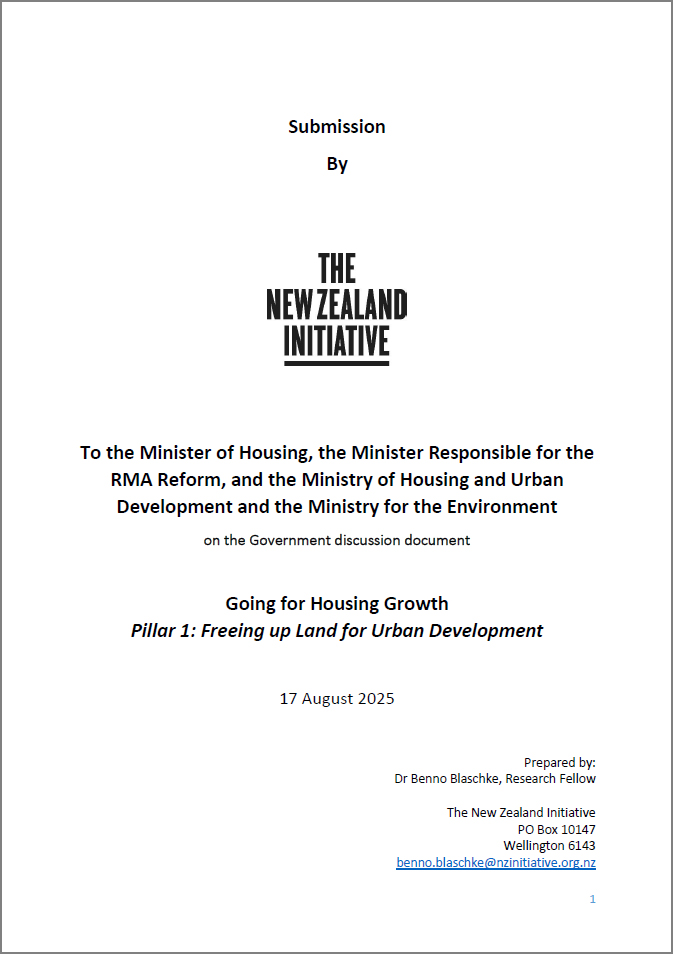The New Zealand Initiative is pleased to submit our comprehensive response to the Government’s Going for Housing Growth Discussion Document focusing on Pillar 1 proposals. This submission represents our analysis of how the proposed reforms can best achieve the stated objective of enabling competitive urban land markets to restore housing affordability in New Zealand.
Executive Summary of Our Position
While we strongly support the Government’s commitment to wholesale system replacement and the three-pillar reform structure, our submission identifies a critical gap between the stated objective of creating competitive urban land markets and the current Pillar 1 proposals, which continue to embed planning practices that constrain development options.
Our core message is clear: True housing affordability requires eliminating ‘scarcity rents’, the artificial price premiums caused by planning constraints that ration development rights. This can only be achieved through credible threat of entry into urban land markets, which requires all three pillars working together.
Key Recommendations
Our submission presents five top-level recommendations for Pillar 1:
- Decouple spatial planning from council finance - Shift from ‘proof of infrastructure readiness’ to ‘confidence in delivery’
- End capacity-based rationing - Remove demand forecasting as a gating mechanism for development permissions
- Separate spatial planning from land use regulation - Create distinct Tier 1 (Metro Major Corridor Planning) and Tier 2 (Local Land Use Regulation) functions
- Adopt standardised template zoning - Enable development by default unless material externalities require management
- Legally entrench permissive rules - Include automatic upzoning triggers when price signals show scarcity
The Three-Legged Stool Problem
Our submission emphasises that the Government’s three-pillar structure correctly recognises these reforms as interdependent, like a three-legged stool that collapses if any leg is missing:
- Pillar 1 must set permissive rules allowing abundant development
- Pillar 2 must provide infrastructure finance independent of council budgets
- Pillar 3 must give beneficiaries of growth power to organise and deliver
Without all three pillars functioning together, the system will fail to create the credible threat of entry necessary to discipline land prices across entire urban areas.
Critical Innovation: Expanding Pillar 3 Scope
Our most important recommendation is that Pillar 3 must go beyond council incentives to create genuine ‘right of assembly’ enabling beneficiaries of growth to bypass council veto when necessary. This reflects the principle of congruence - aligning those who benefit (and lose) from development with those who fund and approve it.
Detailed Analysis Across Four Policy Areas
Our 34-page submission provides detailed analysis and recommendations across the Discussion Document’s four specific policy areas:
- Modelling and Development Capacity - We oppose continued reliance on capacity modelling as a rationing mechanism
- Spatial Planning - We support narrow spatial planning focused on corridor reservation, not integrated management
- Standardised Template Zoning - We advocate for permissive, template-based zoning that enables rather than constrains
- Responsiveness - We argue responsiveness must be built into system design, not added as a procedural override
Supporting Evidence Base
Our recommendations are grounded in extensive domestic and international research, including work by:
- The New Zealand Productivity Commission
- The Housing Technical Working Group (Treasury, HUD, RBNZ)
- The New Zealand Urban Land Markets Group
- Leading international urban economists
Implementation Requirements
We emphasise that these recommendations cannot be implemented without coordinated legislative reform across multiple statutes, reaching into the territory of the Local Government Act 2002 and Infrastructure Funding and Financing Act 2020. The system replacement will require more than just new planning legislation.
Conclusion and Next Steps
The New Zealand Initiative commends the Government’s ambition for full system replacement. However, we stress that Pillar 1 can only succeed as part of a genuinely integrated architecture that creates both the right and the ability to develop when and where it is needed.




